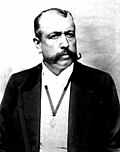| Vice President of the Plurinational State of Bolivia | |
|---|---|
| Vicepresidente del Estado Plurinacional de Bolivia | |
 Coat of arms of Bolivia | |
| Residence | Vice Presidential Palace |
| Seat | La Paz |
| Nominator | Plurinational Electoral Organ |
| Appointer | Direct popular vote (two rounds if necessary) |
| Term length | Five years, renewable once consecutively [1] [2] |
| Inaugural holder | José Ramón de Loayza |
| Formation | 19 November 1826 |
| First holder | Álvaro García Linera [a] |
| Salary | 22,904 bolivianos per month [3] |
| Website | www.vicepresidencia.gob.bo |
 |
|---|
The vice president of Bolivia (Spanish : Vicepresidente de Bolivia), officially known as the vice president of the Plurinational State of Bolivia (Spanish : Vicepresidente del Estado Plurinacional de Bolivia), is the second highest political position in Bolivia. The vice president replaces the president in his definitive absence or others impediment and is the ex officio President of the Legislative Assembly.
Contents
- Vice presidents
- Republic of Bolivia (1826–1836)
- Bolivian State (1836–1839)
- Republic of Bolivia (1880–2009)
- Plurinational State of Bolivia (2009–present)
- Timeline
- See also
- Notes
- References
- External links
Thirty-nine men have served as vice president of Bolivia since the office came into existence on 19 November 1826. José Ramón de Loayza was the first vice president of the Republic of Bolivia. The 38th vice president, Álvaro García Linera, was the last vice president of the Republic of Bolivia and the first vice president of the Plurinational State of Bolivia. There are currently five living former vice presidents. The most recent former vice president to die was Julio Garrett Ayllón on 19 March 2018.
Edmand Lara is the current vice president of Bolivia, having assumed office on 8 November 2025.
The vice president is the first person in the presidential line of succession and assumes the presidency if the president dies, resigns, or is impeached and removed from office. Four vice presidents have ascended to the presidency following the resignation of their predecessor (José Luis Tejada Sorzano, Mamerto Urriolagoitía, Jorge Qurioga, and Carlos Mesa). René Barrientos was the only vice president to assume the presidency by deposing his own predecessor, Víctor Paz Estenssoro. When Barrientos died suddenly on 27 April 1969, Luis Adolfo Siles Salinas became the only vice president to become president through their predecessor's death.
Seven former vice presidents (Aniceto Arce, Mariano Baptista, Severo Fernández, Eliodoro Villazón, Hernán Siles Zuazo, René Barrientos, and Jaime Paz Zamora) were elected president in their own right while two (José Miguel de Velasco and Mariano Enrique Calvo) became president by other means. José Miguel de Velasco was the only vice president who had already served as president (1828) prior to becoming vice president.










































